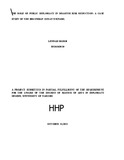| dc.description.abstract | On December 26, 2004 an earthquake on the Indian Ocean triggered a deadly tsunami that claimed the lives of over 220,000 people. The tsunami ravaged 11 countries, leaving coastal cities and communities utterly devastated and millions of natives homeless. Due to the severity of the disaster, countries around the globe immediately pledged their support to provide muchneeded humanitarian aid. Millions of US dollars in monetary assistance, food, supplies, and other necessities poured into the regions affected by the tsunami. This prompt and' generous response from the international community was and continues to be a major factor in the recovery of the destroyed areas. This global concern and response is important while at the same time there are factors that ensure such situations are redeemed on time.
This paper looks at the mechanisms put in place to address international disasters and the networks that are available to ensure international disaster cooperation. In addition to this it explains how the international warning system works and what measures should be put in place to improve on its operations as well as the role of communication in this disastrous situation. The role of media and more so the rise of social media action. The research uses the Recognition-primed decision (RPD) which is a model of how people make quick, effective decisions when faced with complex situations. | en_US |

